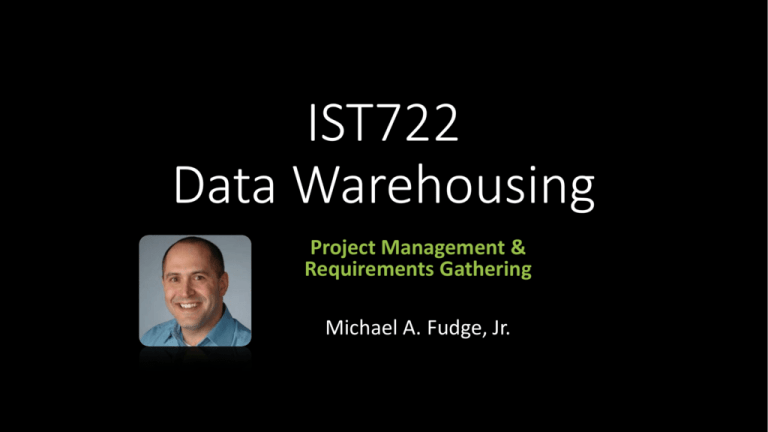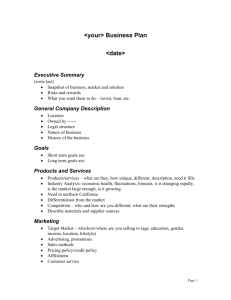unit04-Project-Management-Requirements
advertisement

IST722 Data Warehousing Project Management & Requirements Gathering Michael A. Fudge, Jr. Please arrange into your project teams. Todays’ Agenda: Learn how to get started with a data warehousing initiative…. We’ll use the Kimball Approach…. Recall: Kimball Lifecycle Some Kimball Terminology • Program – Collection of • Project – Single iteration of coordinated projects the entire cycle. • Several Data marts will be • Encompasses a business created. process which results in a data mart. • Ex. Sales BI program: Build data marts for internet sales, • Ex. Build a data mart for store sales, and partner internet sales sales. The Relationships between: Programs, Projects, and Data Marts. Contains one or more… Program Implemented as one or more… Project Data Mart Each project team will work on one project within the same program. Is Your Organization Prepared To Take This On? • First you must assess your organization’s readiness: Do you have strong support from upper management? Is there a compelling business motivation behind the initiative ? It is technically feasible with the resources and data you’re given? Your answer to these questions should be YES Group Activity: Choose a project TODO: Group Remember: you’re all working on the same program. Each of you needs to identify a project you will work on, based on the data in ExternalSources Each group should select a different project. A B C D E F G H Project Planning Activities • The Charter • • • • Define the project background Set project scope and boundaries (what’s excluded). Identify success criteria for the project State the business justification • Assemble the Project Team (at minimum) • • • • • • Business Lead - In charge of initiative Project Manager – Manages project Business Analyst – Collects requirements Data Architect – Dimensional Modeling / Implementation ETL Architect – ETL Design / Implementation BI Architect - BI Design / Implementation Group Activity: Charter and team TODO: Write up your charter for the chosen group project. Select primary roles for each team member. Each team member should have 2 roles. • The Charter • Define the project background • Set project scope and boundaries (what’s excluded). • Identify success criteria for the project • State the business justification • The Project Team • • • • Business Lead - In charge of initiative Project Manager – Manages project Business Analyst – Collects requirements Data Architect – Dimensional Modeling / Implementation • ETL Architect – ETL Design / Implementation • BI Architect - BI Design / Implementation Planning Activities • Establish a Communication Plan • How will you keep stakeholders informed? • How often and in what form will you meet? • Who needs to be present at which meetings? • Create your Project Plan and Task List • Track issues using a change log or issue tracking system. • Hold a Kickoff meeting to get everyone on the same page. Requirements Gathering Key Activities of Requirements Gathering • Interviews with business users. • Data Audits – data profiling to assess capabilities of data sources. • Documentation, including Interview Write-ups Identify Business Processes Enterprise Bus Matrix Prioritization Grid Issues List Sample Interview Questions • What type of routine analysis do you perform? What data is used and where do you get it? What do you do with the data once you get it? • Which reports do you use? Which data on the report is important? If the report were dynamic what would it do differently? • Describe your products. How do you distinguish different products? How are they categorized? Do categories change over time? Data Profiling • One important activity is to explore your existing data to get a sense of • Technical feasibility of the project • Structure and condition of data • Availability of Data Sources • We call this Data Profiling • If the source data is in a relational database, you can use the SQL SELECT statement to profile data. • For other sources, Microsoft Excel makes for a good data profiling tool. Data Profiling Example • You can use tools like Excel to profile your data, searching for useful dimensions and facts. By Country By Year TotalSales Column Labels Row Labels 2006 2007 2008 Grand Total United States 15,535,349 20,563,610 25,963,721 62,062,681 United Kingdom 550,507 5,083,062 6,257,260 11,890,829 Canada 3,591,852 2,763,865 5,147,140 11,502,857 Australia 2,568,701 2,099,585 5,805,290 10,473,577 France 414,245 2,021,672 4,714,497 7,150,415 Germany 513,353 593,247 3,574,747 4,681,348 NA 186,518 558,762 1,251,447 1,996,727 Grand Total 23,360,526 33,683,805 52,714,103 109,758,434 Critical Skill: Turn business processes into dimensional models! Here’s the process for building a dimensional model from a business process. This dimensional model will eventually become a star schema in your enterprise data warehouse. 1. Identify the business process and business process type. 2. Identify the facts of the business processes. 3. Identify the dimensions of the business process. Demo of my amazing modeling skills!!!! Business User Says: “I need to know: How many sneakers did we sell last week?” What I hear Quantity (Fact) Product Type (Attribute of a Product Dimension) Business Process (Sales) Duration of Time (Attribute of a Sales Date Dimension) • Facts are the business process measurement events • Dimensions provide the context for that event. #1: Identifying Business Processes 3 types: 1. Events or Transactions 2. Workflows a.k.a. Accumulating Snapshots 3. Points in time a.k.a Periodic Snapshots Business processes contain facts which we use end up being the fact tables in our ROLAP star schemas. Transaction Accumulating Snapshot Periodic Snapshot Transaction Fact • The most basic fact grain • One row per line in a transaction • Corresponds to a point in space and time • Once inserted, it is not revisited for update • Rows inserted into fact table when transaction or event occurs • Examples: • Sales, Returns, Telemarketing, Registration Events Accumulating Snapshot Fact • Less frequently used, application specific. • Used to capture a business process workflow. • Fact row is initially inserted, then updated as milestones occur • Fact table has multiple date FK that correspond to each milestone • Special facts: milestone counters and lag facts for length of time between milestones • Examples: • Order fulfillment, Job Applicant tracking, Rental Cars Periodic Snapshot Fact • At predetermined intervals snapshots of the same level of details are taken and stacked consecutively in the fact table • Snapshots can be taken daily, weekly, monthly, hourly, etc… • Complements detailed transaction facts but does not replace them • Share the same conformed dimensions but has less dimensions • Examples: • Financial reports, Bank account values, Semester class schedules, Daily classroom Lab Logins, Student GPAs Group Activity: Which Fact Table Grain? 1. 2. 3. 4. 5. 6. 7. 8. Concert ticket purchases? Voter exit polls in an election? Mortgage loan application and approval? Auditing software use in a computer lab? Daily summaries of visitors to websites? Tracking Law School applications? Attendance at sporting events? Admissions to sporting events at 15 minute intervals? Transaction Accumulating Snapshot Periodic Snapshot Answers: Which Fact Table Grain? 1. 2. 3. 4. 5. 6. 7. 8. Concert ticket purchases? T Voter exit polls in an election? T Mortgage loan application and approval? AS Auditing software use in a computer lab? T Daily summaries of visitors to websites? PS Tracking Law School applications? AS Attendance at sporting events? T Admissions to sporting events at 15 minute intervals? PS Transaction Accumulating Snapshot Periodic Snapshot #2 Identify the facts of the business process. • Facts are quantifiable numerical values associated with the business process. • • • • How much? How many? How long? How often? • If its not tied to the business process, its not a fact. • For example: • Points Scored == Fact, Player He 3 Types of Facts • Additive - Fact can be summed across all dimensions. • The most useful kind of fact. • Quantity sold, hours billed. • Semi-Additive - Cannot be summed across all dimensions, such as time periods. • Sometime these are averaged across the time dimension. • Quantity on Hand, Time logged on to computer. • Non-Additive - Cannot be summed across any dimension. • These do not belong in the fact table, but with the dimension. • Basketball player height, Retail Price Group Activity: Facts or Not?? Additive? Semi? Non? 1. Number of page views on a website? 2. The amount of taxes withheld on an employee’s weekly paycheck? 3. Credit card balance. 4. Pants waist size? 32, 34, etc… 5. Tracking when a student attends class? 6. Product Retail Price? 7. Vehicle’s MPG rating? 8. The number of minutes late employees arrive to work each day. Answers: Facts or Not? Additive? Semi? Non? 1. Number of page views on a website? F/A 2. The amount of taxes withheld on an employee’s weekly paycheck? F/A 3. Credit card balance. F/S 4. Pants waist size? 32, 34, etc… N/A 5. Tracking when a student attends class? F/A 6. Product Retail Price? N/A 7. Vehicle’s MPG rating? N/A 8. The number of minutes late employees arrive to work each day. F/A #3: Identify the Dimensions • Dimensions provide context for our facts. • We can easily identify dimensions because of the “by” and/or “for” words. • Ex. Total accounts receivables for the IT Department by Month. • Dimensions have attributes which describe and categorize their values. • Ex. Student: Major, Year, Dormitory, Gender. • The attributes help constrain and summarize facts. Group Activity: Try these • Identify: Business Process, Fact and Dimensions 1. What’s the total amount of product shipped by sales region for 2010-2014? 2. What’s the average time in days for a student’s application to be processed? 3. How many employees wait more than 15 minutes for a bus to the Manley parking lot? Q:How do you document this? A: Enterprise Bus Matrix • A key deliverable from requirements gathering, the bus matrix documents your business processes, facts and dimensions across all projects in your program. Group Activity: Bus Matrix TODO: Identify the business processes, facts and dimensions for your group’s business process. Your prof will create an enterprise bus matrix based on the entire program. • Identify Business Processes • Transaction • Periodic Snapshot • Accumulating Snapshot • Identify Facts of the business process • Should be Additive, or at least Semi-Additive • Identify the dimensions used by the business process Prioritization Grid In Summary • The initial phases of the Kimball Lifecycle are project planning and requirements analysis. • First your organization must assess its readiness to take on the project. • In the project planning phase you should establish the project charter and assemble the team. • In the requirements phase you should interview business users, conduct data audits, and write up documentation. • You documentation should include an enterprise bus matrix to layout business processes & conformed dimensions and a prioritization grid highvalue targets. IST722 Data Warehousing Project Management & Requirements Gathering Michael A. Fudge, Jr.





